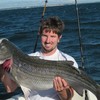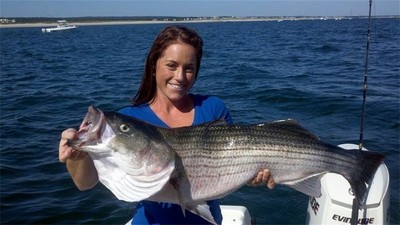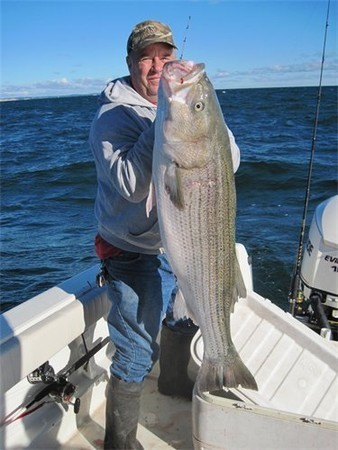Originally postedin the Sports sectionof Barnstable-Hyannis Patch
http://barnstable-hyannis.patch.com/articles/live-lining-springtime-cow-bass
We're in business," is what I recall saying to the crew upon seeing the biomass of stripers on the sonar. "Pitch the baits!"
I was fishing with Mike and Mark, two Missouri natives who were yet to catch a bass over 18 pounds. The two rooks were about to experience the difference between Midwestern landlocked stripers and their much larger saltwater cousins. It took less than a minute for the big bass to zone in on the guys' live baits.
"Fish on!" yelled Mark as line began sizzling off his light tackle setup. "I'm on too!" chimed in Mike, as he set the hook into the jaw of a heavy Cape Cod striper.
For the next 10 minutes the guys tangoed around each other on the deck of the Miss Loretta, until we finally caught a glimpse of the first bass.
"That is a nice fish!" shouted Mark in his thick southern drawl.
I reached down, secured a firm grip in the bass' jaw, and heaved the fish over the gunnel. We had only a few seconds to admire Mark's fine catch until Mike had his big bass boat side.
"Man oh man that's a lunker," said Mike as I heaved his bass aboard the boat.
After a few high fives we weighed the two cows in at 34 and 36 pounds-the biggest two bass Mike and Mark had ever caught.
Over the next six hours the two guys from Missouri boated 38 big bass up to 37 pounds all on live bait. They were ecstatic and so was I. Fresh live baits had made it possible for these two rookies to catch more keeper stripers in one trip than many anglers catch during the entire season.
Mike and Mark are a prime example of why live-lining works so well. Fishing with livies provides amateur anglers with a strong chance at catching a big fish. For experienced fishermen, few techniques compare to the efficiency and effectiveness of fishing live baits for cow sized striped bass.
In a few weeks the first keeper bass will invade the waters around Barnstable. Live lining will once again prove to be one of the most effective means for targeting these big fish.
Atlantic Mackerel
It is only a matter of days untilCape Cod Bayis teeming with thousands of Atlantic mackerel. Last year the Bay was also home to a surprisingly large amount of smaller mackerel known locally as tinkers. The tinkers arrived in early May in large concentrations outside the east end of the Cape Cod Canal.
When under stress, mackerel take on a greenish hue and look rather tropical. Bass expend lots of energy hunting down mackerel, since the speedsters are possibly the fastest prey item on the bass' menu. Large bass attacking a school of macks can be an unreal sight. Often times the stripers aggressively pursue mackerel on the surface-the fishing at these times can be truly epic.
Finding and Catching the Bait
Historically speaking, finding and catching mackerel during May is about as easy as it gets. However, there are always days when the mackerel will prove difficult to find. On these days it can pay big dividends to strategically use sonar as discussed in Developing a Strategy for Finding Big Fish.
Homemade sabiki rods make mackerel fishing much simpler. Sabiki rods prevent sabiki rig tangles and allow the sabiki rig to be stored and used multiple times.
To make your own sabiki rod, simply attach an old fishing reel to a five foot long, half inch wide PVC pipe. Drill a hole in the pipe a foot above the reel seat and run the main line through the length of PVC. Tie the end of the line to a sabiki rig, attach a weight and reel the entire rig into the pipe.
Upon locating schools of mackerel, release the sabiki rig from the sabiki rod and allow the rig to drop to the depth where macks have been marked on the sonar. A slow jigging motion usually works well, however it can pay to experiment with depth and jigging action.
Live-lining Macks for Big Bass
Locating quality bass in May differs from finding big stripers during the heat of the summer. Estuaries and the beachfront typically produce more big fish in May than during the summer months. Early in the season, finding big stripers in 25 feet of water is often more common than finding big bass in 60 feet.
The most fun way to live-line mackerel is with light tackle. I will choose light tackle spinning setups when we find fish in areas with little or no current. Simply pitch the mack overboard and allow the bait to do the rest. Watching a tinker get chased on the surface by a thirty pound cow is a sight not soon forgotten.
Often times during May, surprisingly large fish will hold tight to the bottom in areas of current, like harbor channels and estuaries. A three-way swivel rig is one of the easiest ways to live-line mackerel in these spots.
When drifting with the current, it is important to use a weight heavy enough to keep the line nearly vertical. Conventional setups perform this task much better than spinning setups. When a bass hits, resist the urge to immediately set the hook. Instead, lower the rod tip, wait for the line to become taught and then rear back.
Big Bass are Back
By now the first keeper stripers are trickling into Buzzards Bay and Nantucket and Vineyard Sound. Close behind these smallerkeepers are the cow stripers that many of us have dreamt about all winter.
One of the most productive and exciting ways to catch these big fish will be live-lining mackerel. For the angler it is a chance to watch predation in action. Impressive surface feeds ensue when bass are honed in on macks.
As always there will be cow bass caught by fishermen utilizing the May mackerel run. However, the vast schools of mackerel will be more difficult to find once June rolls around. I hope you are able to take full advantage of these upcoming weeks, and take part in on some of the finest spring time fishing our area has to offer.




